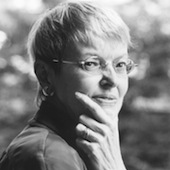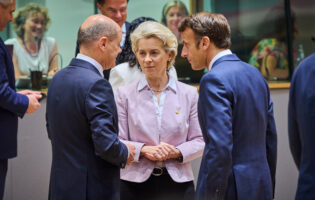Contrary to popular lore, the Berlin Wall did not fall on November 9, 1989. Nor did it fall in Berlin. It fell on October 9 some 120 miles away, in Leipzig. First, civil courage—a rare quality in German history—had to dissolve the four-decade-old mental wall of East German fear. Only thereafter could the cement wall collapse in Berlin.
Here’s how it happened:
When Valentine Kosch set out to join the Monday peace march in Leipzig on October 9, she expected to be shot by the massed East German security forces. She explained to her 6- and 3-year-old daughters that she was going to take a walk with friends so that teachers would be nicer to their pupils—an accurate enough description in her case. And she told her husband that if she did not return by 10 p.m., he should take their girls, move to Dresden, and start a new life there, where the two sisters would not be branded as children of an enemy of the state.
Like most East Germans in the decades after Soviet tanks suppressed the East Berlin workers’ uprising in 1953, Mrs. Kosch was apolitical. Rather than fighting the constraints of the Communist system, she adapted to them, the better to shape her private sphere with a minimum of outside interference.
However, a few years earlier she had spontaneously introduced Montessori methods in the class she taught in the city school system. For this breach of the rules she had been demoted, in effect, to a classroom for special-needs children. She felt stifled by the rigidity of the educational bureaucracy. She was fed up.
The weekly peace vigils that Kosch joined had begun eight years earlier at the Nikolai Church in the medieval town center. It was just around the corner from the St. Thomas Church where Johann Sebastian Bach was once cantor, and where Martin Luther introduced the Protestant Reformation to Leipzig in 1539. The Monday peace prayers followed a joint call by young East and West German theologians for removal from German soil of both NATO and (more discreetly, if more daringly) Soviet nuclear weapons.
Christian Führer, one of the originators of the appeal, was then the new pastor at the Nikolai Church. He conceived of his mission as succoring all who came to him in need, whether believers or non-believers. He is still revered today as the unpretentious denim-jacketed hero of the 1989 transformation, one of those clerics who showed compassion for all, did not collaborate with the Stasi secret police, and conferred on the Protestant Church a moral authority that it alone possessed in the (East) German Democratic Republic (GDR).
Throughout the 1980s, the Nikolai peace vigils had attracted a loyal but tiny number of participants. In 1989 the ranks swelled exponentially as two separate strands of exasperation came together. The first movement consisted of modest reformers, like Kosch, who wanted to hold the GDR to its own constitution and laws and their provisions for fair elections and human rights. The second consisted of the growing number of East Germans who simply wanted to escape to the normality of West Germany’s casual freedom and opulence, in the wake of more than a hundred thousand compatriots who had in recent weeks abandoned country and possessions to flee west via Hungary, Czechoslovakia, and Poland.
People in the two categories disdained each other, but Pastor Führer—while personally urging everyone to stay at home and build East Germany—opened the Nikolai haven to both persuasions. Indeed, he reconciled them to each other, in part through their common interest in his Monday updating of the list of those who shouted out their names as they were secretly hauled off to jail.
With our contemporary knowledge of the outcome, it is hard to recall just how much courage Kosch and her fellow marchers required twenty years ago to carry their candles on that disciplined hour-long walk around the old town, right past the Leipzig Stasi headquarters. At the time many in both East and West feared that although detente was blossoming in Europe, an anachronistic hardline East German hierarchy could hang on for a long time (on the pattern, say, of North Korea today).
The Stasi—whose ranks maintained a much higher ratio in proportion to the population than Hitler’s SS ever enjoyed—still held tight control. And East German citizens still shared with the Bulgarians the reputation of being the most quiescent people in the Soviet bloc.
Moreover, there had been a nasty crackdown over the weekend. On October 7 and 8, security forces had detained several thousand demonstrators in Leipzig, Dresden, and East Berlin on the occasion of the GDR’s gala fortieth anniversary. In Leipzig the watchdogs, tone-deaf to history, had even rehearsed plans to inter thousands of dissidents in new concentration camps. Hospitals had been stocked with extra blood plasma in preparation for a Monday-night clash, and Leipzigers knew it. The city’s security contingents, reinforced to 8,000—only 2,000 short of the record turnout of 10,000 peace watchers the previous Monday—had been issued with live ammunition and ordered to use whatever means were required to suppress the “counterrevolution,” the most serious crime in the Communist books.
By all measures of the previous 36 years, this show of power should have sufficed to keep would-be marchers safely at home.
But what was the fallback if intimidation didn’t work this time? Throughout the day, as confrontation loomed, the Leipzig party secretaries tried in vain to elicit new instructions from East Berlin party headquarters. Leipzig Gewandhaus Orchestra director Kurt Masur, theologian Peter Zimmermann, deputy city party secretary Roland Wötzel, and three others hammered out an urgent appeal for nonviolence, to be read in all the churches and broadcast on radio. Marchers braced themselves to hold each other back from any rash action or reaction.
At 6 p.m., the hour the Nikolai congregation was to leave the church and walk around the inner city ring, the top Leipzig party secretaries made one last desperate phone call to East Berlin, to Egon Krenz, the deputy and heir apparent to veteran strongman Erich Honecker. Krenz had risen as high as he had by never sticking his neck out. This night was no exception. He equivocated and said he would have to consult the others.
After Leipzig party secretary Helmut Hackenberg hung up the phone, “a very, very long time passed,” said Wötzel later, recalling the eternity of the next few minutes. Then Hackenberg asked his deputies, “What do we do now?” One shot by a jumpy 18-year-old in the ill-trained factory militia, or one step too far by an angry marcher—or a Stasi provocation—could have triggered an explosion.
Under the circumstances, it was marginally less risky to nullify sacrosanct standing orders than to dare bloodshed that their superiors might later blame on them. The junior secretaries urged Hackenberg to disengage the security forces. He did so, by deploying them instead to guard official buildings (which were never under any threat). The Leipzig officials fully expected to be expelled from the party for taking such forbidden local initiative.
Yet their wariness about the new mood on the street was justified. Not only were the 10,000 of the previous week not scared away. Astonishingly, they were joined by 60,000 others who also cast aside their fear and walked past Stasi headquarters chanting, “Wir sind das Volk.” “We are the people.”
Germany’s first successful revolution in history was bloodless. East German parliamentary Speaker Horst Sindermann famously admitted later, “We were ready for everything—everything except candles and prayers.”
As Pastor Führer commented in an interview, reflecting on that night: “We were afraid day and night, but we had the courage of our convictions. The Bible had taught us the power of peaceful protest and this was the only weapon we had…. It still moves me today to recall that in a secular country, the masses condensed the Beatitudes in the Lord’s Sermon on the Mount into two words: No violence!”
Observant East Berliners and Eastern Europeans quickly realized that in Soviet leader Mikhail Gorbachev’s new era, if enough demonstrators turned out, the security forces would not shoot. Within weeks the East German, Czech, Bulgarian, and Romanian Communist leaders were all deposed.
“For the first time in my life,” confided a forty-something West German who had long been inured to the shame of the German failure to resist Hitler in the 1930s or to establish a republic in 1848, “I’m proud to be a German.”
This article originally appeared in the October 8, 2009 edition of The Christian Science Monitor.
Elizabeth Pond is a Berlin-based journalist, the author of The Rebirth of Europe, and a former AGI Fellow.









